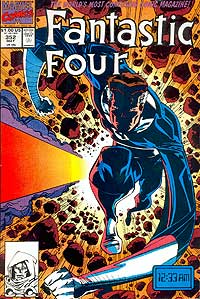
|
The so-called "Mighty Marvel Manner," a combination of idiot-level exposition, purple prose, absurdly contrived fight scenes and melodramatic pathos, can be done right or wrong. Mostly it gets done wrong. But when done right, as by its founders Jack Kirby and Stan Lee, and here by Simonson, it can be a delight and impossible to put down. On the first page of this four-issue series Dr. Doom hovers over a storm-swept castle as his doom-bots, "the banshees of hate," come, "skirling down through the sleet... carried on the wings of the whistling wind!" I challenge you not to turn the page.
By page two we get rompin'-stompin' mayhem, and by page five we get the first of three major plot twists. Dr. Doom has returned from his travels and immediately plots revenge against the Four, luring one of their members to his home. When the others come looking, each gets caught in an ingenious trap until just one remains. Then it's Dr. Doom vs. Reed "Mr. Fantastic" Richards, who sums it up this way: "You propose a battle in time? With the lives of my family as the stakes?" With this cliffhanger, it ends.
Issue 350 stands out as a top example of classic superhero-genre comic making: story surprises, dynamic action scenes told in clear yet exciting layouts, and characterizations that have life while remaining iconic. But really it just sets up issue 352, as radical a comic as Marvel ever put out.

|
Most of the pages are split down the middle. On one side Doom battles Richards in a disjointed, black-and-white battle through the past and future minutes that surround the story of the other team-members, told in color next to it. The stories interconnect when they are both in the same time and the same place. A clock readout that accompanies both story lines allows you to actually follow the whole thing from either point of view.
If there were professors for such a thing, they might call this work a "pure comic" — induplicable in any other medium. You must use the visual clues to read the full sequence of events, sending you physically back and forth through the work.
This must have been a real chore to work out, but the details are remarkable. For example, panels are comics' most common denotation of time, so it makes sense that the "timeless" Richards/Doom sequences take place more or less without them. Look carefully and you may also notice that these single, long panels are made to seem on top of, not next to the linear panels of the other, more conventional, story. Simonson's visual motif reflects the nature of the story being told, namely a battle outside of time yet related to the events underneath it.
The other two issues of this Walt Simonson run, 353 and 354, are more or less denouements to the story that begins and ends in 350 and 352. Still, they are highly imaginative and even funny, involving the team's tangle with a cosmic bureaucracy known as the Time Variance Authority.
This brief, bold and highly entertaining series are masterpieces of pure comics manipulation, and the kind of fun read that got most of us into comics in the first place. Dare I say, "Excelsior"?
These issues should be easy and cheap to find in any comic store with a halfway decent back stock. Mile High Comics offers "fair-condition" copies for 50 cents. I do not think they were ever collected in a trade paperback.
